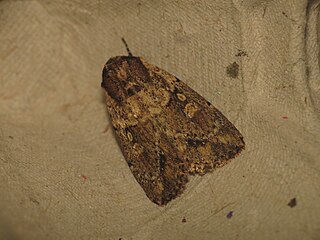Calymniops is a monotypic moth genus of the family Erebidae erected by George Hampson in 1926. Its only species, Calymniops trapezata, was first described by Frederic Moore in 1887. It is found in India, Sri Lanka, Japan and parts of North America.

Claterna is a monotypic moth genus of the family Noctuidae erected by Francis Walker in 1858. Its only species, Claterna cydonia, was first described by Pieter Cramer in 1775.

Delgamma is a monotypic moth genus of the family Noctuidae erected by Frederic Moore in 1885. Its only species, Delgamma pangonia, the strawberry cutworm, was first described by Achille Guenée in 1852.

Episparis is a genus of moths in the family Erebidae erected by Francis Walker in 1857.

Sasunaga tenebrosa is a moth of the family Noctuidae first described by Frederic Moore in 1867. It is found from the Indian subregion, Sri Lanka to Sundaland, the Philippines and Sulawesi.

Kandy railway station is a major railway station in Kandy, Sri Lanka. The station is served by Sri Lanka Railways and is the primary railway station in Kandy and one of the most significant in the central hills. The station sits on a branch of the Main Line, leading to the Matale Line.

Tyspanodes linealis is a moth in the family Crambidae. It was described by Frederic Moore in 1867. It is found in the Bhutan, the Himalayas, Sri Lanka, the Andamans, Thailand and Australia, where it has been recorded from Queensland.
Barsine defecta is a moth of the family Erebidae first described by Francis Walker in 1854. It is found in Sri Lanka, Nepal, Thailand and Vietnam. It is the type species of genus Barsine.
Episparis varialis is a moth of the family Erebidae first described by Francis Walker in 1859. It is found in India and Sri Lanka. The binomial name is sometimes classified as a junior objective synonym of Phalaena liturata.

Odonestis bheroba is a moth of the family Lasiocampidae first described by Frederic Moore in 1858.
Antheraea cingalesa, the Sri Lankan tussar silk moth, is a moth of the family Saturniidae. The species was first described by Frederic Moore in 1883. It is endemic to Sri Lanka.
Episparis liturata is a moth of the family Noctuidae first described by George Hampson in 1893. It is found in India, Sri Lanka, Java, Borneo, Myanmar, China and Thailand.

Tipasa renalis is a moth of the family Noctuidae first described by Frederic Moore in 1885. It is found in Sri Lanka, Taiwan and Borneo.

Corymica specularia is a moth of the family Geometridae first described by Frederic Moore in 1867. It is found in Sri Lanka, India and Taiwan.

Craniophora fasciata is a moth of the family Noctuidae first described by Frederic Moore in 1884. It is found in Sri Lanka, Japan, Korea, Taiwan, Thailand and Australia.
Trisula variegata is a moth of the family Noctuidae first described by Frederic Moore in 1858. It is found in India, Sri Lanka, Nepal, Thailand, South China, Indonesia and the Philippines.
Leucania venalba is a moth of the family Noctuidae first described by Frederic Moore in 1867. It is found in Indo-Australian tropics of India, Sri Lanka, to Fiji and New Caledonia.

Mythimna reversa is a moth of the family Noctuidae first described by Frederic Moore in 1884. It is found in the Indian subregion, Sri Lanka, Borneo, the Philippines, Hong Kong, Malaysia and Australia.

Lophoruza lunifera is a moth of the family Noctuidae first described by Frederic Moore in 1885. It is found in Sri Lanka, Japan and Taiwan.
Selepa celtis, called the hairy caterpillar as a larva, is a moth of the family Nolidae. The species was first described by Frederic Moore in 1858. It is found in Oriental tropics of India, Sri Lanka, Taiwan towards the Ryukyu Islands and Australia.












